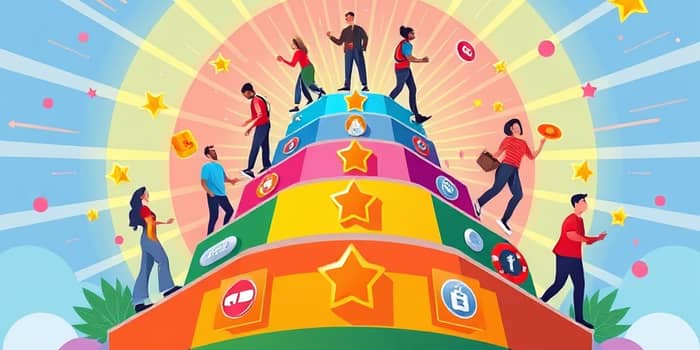
In today’s fast-paced business landscape, capturing and retaining attention is more challenging than ever. A well-structured tiered reward system transforms routine interactions into an engaging journey, driving participants to return, recommend, and invest more deeply. By weaving together motivational psychology and tangible incentives, organizations can craft experiences that resonate on both emotional and behavioral levels.
At its essence, a tiered reward system is a framework where participants progress through defined levels by meeting specific criteria—such as points accumulated, purchases made, or milestones achieved. Each tier presents an elevated set of rewards, ranging from basic discounts to luxury perks like early access to new products or personalized concierge services.
Unlike one-off promotions, these multi-level structures create a dynamic growth pathway, encouraging consistent participation. Whether users engage via mobile apps, in-store visits, or digital platforms, the promise of unlocking the next tier fosters anticipation and deeper brand affinity.
Successful systems may blend qualitative and quantitative metrics, awarding progress for actions like writing reviews, referring friends, or engaging on social media. This flexibility allows companies to align program goals—such as community building or increased sales—with user motivations.
Several psychological principles underpin the allure of tiered incentives. First, the goal-gradient effect illustrates that individuals work harder as they perceive themselves nearing a reward threshold. This creates sustained effort rather than sporadic spikes in engagement.
The endowment effect further enhances value perception: once users gain access to a tier, they assign greater value to its benefits and fear losing them, driving continued loyalty. Scarcity and exclusivity also play vital roles by positioning upper tiers as coveted status symbols that only a select few achieve.
By leveraging these mechanisms, brands can create sense of achievement and pride that fuels long-term behavior change.
Industry leaders provide clear roadmaps for implementing effective tiered programs. Take Starbucks Rewards: members earn stars for each purchase, moving from Green to Gold status with perks like free birthday drinks and unlimited refills. The simplicity of star accumulation combines with the excitement of milestone celebration.
Sephora’s Beauty Insider program illustrates how financial thresholds translate into experiential rewards. After spending $350 annually, users reach VIB status, unlocking free shipping and exclusive product previews. At $1,000, Rouge members receive invites to luxe events and custom makeovers. This concrete progression drives shoppers to consolidate beauty spending within Sephora’s ecosystem.
MoxieLash integrates both purchase and referral incentives. As customers upgrade tiers, they enjoy higher discounts and referral credits, generating organic growth through word-of-mouth. Across these cases, clarity of rules and appeal of benefits remain consistent success factors.
Data consistently shows these programs yield up to 1.8x higher ROI compared to non-tiered loyalty schemes, emphasizing the financial impact of well-structured rewards.
To develop a tiered system that resonates, begin by defining clear tier levels and straightforward criteria. Ambiguity erodes trust and dampens motivation. Communicate requirements and benefits in plain language across all touchpoints.
Balance is key: tiers should be challenging enough to inspire effort but reachable within a reasonable timeframe. Incorporate “mini-wins” such as personalized coupons or surprise gifts to maintain momentum among lower-tier participants and prevent disengagement.
Robust analytics form the backbone of a thriving program. Track both high-level outcomes and granular behaviors to uncover trends. Quantitative metrics include customer retention rates, average transaction value, and frequency of tier upgrades.
Equally important is qualitative feedback—surveys, focus groups, and social listening reveal user perceptions and unmet needs. By coupling data-driven optimization with direct customer insights, teams can iterate reward structures, refine communication, and adjust thresholds for maximal impact.
While tiered loyalty schemes shine in retail, the model extends to employee engagement, digital subscriptions, and volunteer programs. Companies can award internal tiers based on performance quotas, innovation contributions, or peer nominations, fostering a culture of recognition and motivation.
Educational platforms and nonprofit organizations likewise benefit. Learners progress through levels by completing courses, contributing knowledge, or mentoring peers. Volunteers earn badges and public acknowledgment, translating effort into tangible recognition that drives ongoing participation.
In every context, the underlying power lies in combining structured progression with meaningful rewards that align with individual aspirations and organizational goals.
Deploying a tiered reward system is more than a promotional tactic—it’s a strategic investment in building lasting relationships. By weaving psychological insight into program design and rigorously measuring outcomes, organizations lay the foundation for sustainable engagement, loyalty, and growth.
Embrace the journey: map out clear tiers, articulate rewards that resonate, and iterate based on real-world feedback. When participants feel valued and see a path toward elevated status, they won’t just transact—they’ll champion your brand at every turn.
References













